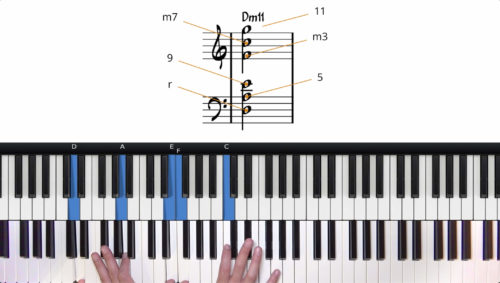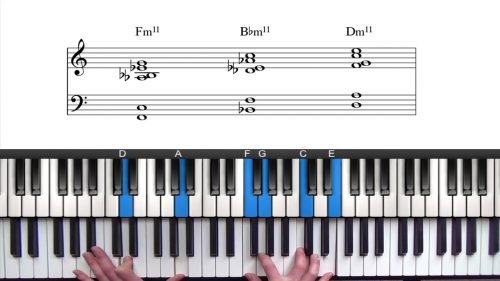Adding Chord Extensions
In this lesson we introduce chord extensions including the tones 9, 11, and 13. Chord extensions are used to create richer and more interesting sounding chord voicings and they are used extensively in solo jazz piano performance.
If you’re new to jazz piano chord extensions check out our extended chord voicings lesson which will guide you through the underlying theory of chord extensions and where they are derived from.
Extended Chord Voicings For Eb-7
We begin by exploring chord extensions for the first chord in the form – the Eb-7 chord. We introduce the extended tones 9th and 11th to create richer sounds and we emphasise the importance of familiarising yourself with these common extended voicings shapes.
The Importance Of The Melody Note
We emphasise the importance of choosing voicings which are compatible with the melody note. Sometimes the melody itself can be a chord extension and so it’s always important to analyse the melody in terms of scale degrees relating to the underlying harmony.
We also discuss chord voicing options when there is a rest in the melody. Rests in the melody provide freedom for more creative voicing choices as we are not constrained by the melody note.
3 Useful Minor Chord Voicings
We apply 3 very useful extended voicings for minor chords which are:
- The “So What Chord Voicing”
- The “Herbie Hancock Chord Voicing”
- The “Kenny Barron Chord Voicing”
Here are these 3 voicings for an Eb Minor chord:

Check out the 3 related lessons below which will take you to dedicated tutorials on these 3 chord voicings. It’s recommended to learn these 3 voicings in all 12 keys are they are very useful and versatile extended minor chord voicings.
Lesson Downloads
-
Chord Extensions File Type: pdf
Practice Tips
-
Always analyse the scale degree of the melody in relation to the underlying harmony. This helps us to choose the most suitable extended chord voicing that works with the given melody note.
-
Common chord extensions for major and dominant chords are the 9th, and the 13th.
-
For minor chords the 9th and the 11th are the most common chord extensions as we see in the examples used in this lesson.
-
Remember that the melody note can often be a chord extension, eg. the 9th in the melody over the Ab7 in bar 2, and the 11th in the melody over the C-7b5 in bar 6.
-
Make sure that you can play the A section with simple 3-note spread voicings and once comfortable with the basic voicing shapes you are ready to introduce the extended chord tones that we cover in this lesson.







